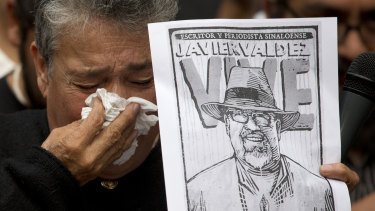Mexico City: Hours after receiving a death threat from a man claiming to be one of Mexico’s most dangerous criminals, the news anchor took to the air again.
At 9.59pm on Monday, Milenio Television anchor Azucena Uresti posted a photo of herself smiling, sitting on a desk in an airy dress and impeccable makeup on Twitter and said she would be on her news show as usual. A minute later, the broadcast began.
“This morning, an alleged criminal group issued threats against several media outlets and against myself for the journalistic work we do in Michoacán,” she said, delivering the news as if she wasn’t now at the centre of country’s biggest story.
Mexican news anchor Azucena Uresti.
Early Monday morning, a video began circulating on social media in which a man claiming to be Nemesio Oseguera Cervantes, the head of Mexico’s notorious Jalisco New Generation cartel, promised to murder her. He was surrounded by seven masked men armed with assault rifles.
“Wherever you are, I’ll find you,” the man said, “and I’ll make you eat your words even if I’m accused of femicide.”
Even in a country ranked among the world’s most dangerous for journalists, the scene was striking: One of the Western Hemisphere’s most powerful criminal organisations threatening a national television news anchor over “biased media coverage”.
One hundred and twenty-four reporters and media workers have been killed in Mexico since 2000. Violence targeting journalists has worsened since President Andrés Manuel López Obrador took office in 2018. Twenty-four media workers have been killed in the last three years; last year, Mexico was the deadliest country in the world for journalists, according to the Committee to Protect Journalists.
Still, analysts say, the threat against Uresti stands out.
“I cannot recall a case in which the head of a major drug trafficking cartel directly threatened a news anchor,” said Jan-Albert Hootsen, Mexico representative for the Committee to Protect Journalists.
The Jalisco cartel is known for boasting about its large arsenal and threatening its rivals on social media. In 2020, the cartel uploaded a video showing men dressed in military attire and holding .50-caliber rifles with dozens of armoured vehicles and pledging loyalty to Oseguera Cervantes, known as El Mencho. A month ago, the cartel tweeted a video in which drug cartel members can be seen delivering mattresses and bed frames to people who live in flooded areas after intense summer rains.
A mother who became active in the search for Mexico’s missing after four of her sons disappeared, weeps after speaking about murdered journalist Javier Valdez during a protest against the killing of reporters in Mexico City in 2017.Credit:AP
“This is the same group that allegedly planned and carried out an attack on the head of Mexico City’s police not too long ago,” said Hootsen, “and that has organised and carried out deadly attacks on federal security forces, including the Mexican army.”
But the public threat to a journalist was new.
As Monday’s video went viral, tweets supporting Uresti flooded her account. They came from novelists, political analysts, fellow journalists, senators and former presidents. Michoacán’s governor, Silvano Aureoles, wrote: “the threat against @azucenau and @Milenio is very serious and should not be taken lightly.”
A group of 19 media companies including the country’s most prominent broadcasters called on officials to act.
“We expect a public statement from the federal government condemning these events and the reassurance that those who so blatantly express themselves on social media be apprehended and taken to trial,” they wrote in an open letter.
López Obrador mentioned Uresti in his Tuesday morning news conference.
“I want to tell her that she can count on us,” he said. “Since I heard, I gave instructions to assist her.”
The British freedom-of-expression group Article 19 documented 154 threats against reporters in Mexico in 2020. Most were delivered privately and anonymously via direct messages on social media.
Mexican journalists at greatest risk are those who work for small, underfunded local outlets, publish directly on social media, report for community radio stations or print modest weeklies. Those who have been killed reported on local politicians and criminal organisations, or the intersection between them – sometimes unintentionally, through coverage of sports or parties.
The video Monday recalled the threat received by journalist Héctor de Mauleón in 2017. That video, posted on Twitter, showed a black and white photograph of the journalist’s face while someone shot at it.
On Tuesday, de Mauleón called the threat against Uresti “the most full-frontal attack against the press that has been made by an armed group”.
The message to Uresti included a threat of gender-based violence.
“Women who live off their bodies do so proudly, they don’t hide behind broadcast companies or newsrooms to make money,” said the man who claimed to be Oseguera Cervantes.
Advocates and analysts saw that language as a clear sign of the way women – especially prominent women – are targeted on social media in Mexico.
“It’s common for female journalists to receive threats mentioning their bodies, private lives and their ‘moral’ conduct,” said Paula Saucedo, protection and security officer at Article 19.
Mexico is an increasingly dangerous country for women. An average of about 10 women are killed here per day, according to the Washington-based Centre for Strategic and International Studies. The rate has doubled in the past five years.
On Monday, Uresti was placed under Mexico’s program to protect journalists and human rights defenders. It offers protection including relocation, bulletproof vests and personal bodyguards. It was unclear what was provided to Uresti.
Presidential spokesman Jesús Ramírez Cuevas said the Mexican government would take “appropriate measures to protect threatened journalists and media”.
Nearly 1500 journalists and activists are in the program. Others have fled their homes or stopped doing journalism altogether.
Washington Post
Get a note direct from our foreign correspondents on what’s making headlines around the world. Sign up for the weekly What in the World newsletter here.
Most Viewed in World
From our partners
Source: Read Full Article




